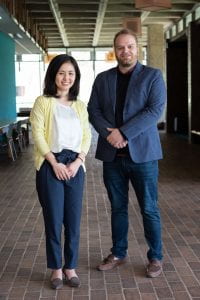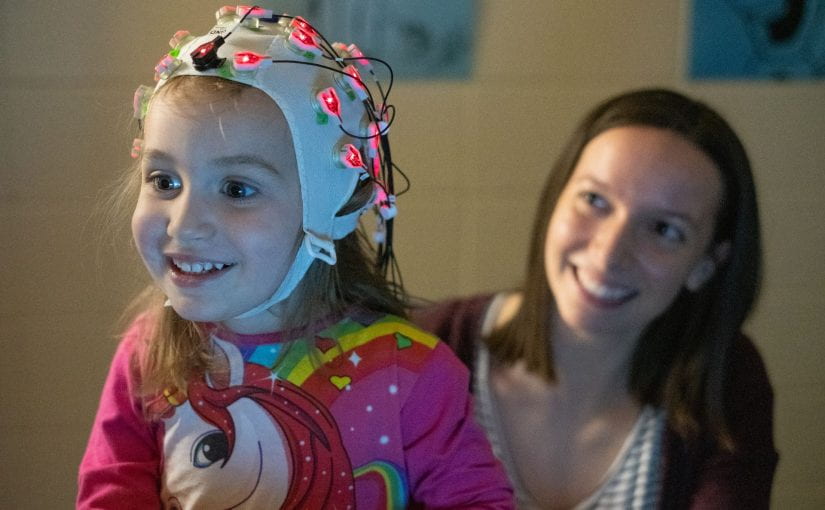Everyone has a moral compass, but at what age does it develop? Is it elementary school, preschool or even earlier? And what role does culture play? That’s the question two University of Wisconsin-Green Bay professors are trying to answer.
UW-Green Bay psychology and human development professors Sawa Senzaki and Jason Cowell are working with groups of 3- and 4-year-olds from the Green Bay region and Japan to study cultural similarities and differences in children’s moral judgements. With $365,508 in funding from the National Institute of Health (NIH), the duo along with their students are researching “The Role of Parental Socialization in the Neurophysical Development of Moral Evaluation Across Cultures.”

While the study is far from being done, the researchers said some cultural changes already have been noted. The children in the study wear an electroencephalographic (EEG) “hat” that measures and records neurophysiological brain activity while watching a cartoon.
“We’ve already noticed that in the U.S., parents talk about the action of a character, such as pushing someone, and why that action was bad. In Japan, parents talk more about the feelings of the person being pushed,” said Cowell, an associate professor and vice chair of the psychology department.
Senzaki, who arrived at the University in 2013, has a background in cultural psychology and is interested in how parenting is shaped by culture. Most of psychology research is done in Canada, the United States and Western Europe, and Senzaki says she searches for ways to expand research with other cultures.
Cowell arrived at UW-Green Bay in 2015 with an interest in developmental neuroscience, including “looking” at children’s brains as they’re starting to learn new skills.
“Sawa saw how our research interests could fit together on a project,” he said. “It was the debate of nature versus nurture involving child development.”
Receiving the NIH grant was a big surprise — about 7 percent of all applications are successful — but one that Senzaki and Cowell definitely celebrated.
“It has opened the door for the research so that even more can be looked at,” Cowell said. “It’s impressive a university the size of UW-Green Bay won this grant especially since the students involved are undergrads and not PhD candidates.”
The NIH grant allows the University to conduct more thorough research, Cowell said. “It allows us to do some really cool research and recognizes we’re a growing university and that we can enhance our students’ experiences with research,” he said.
Senzaki said the grant allows students to participate as paid research assistants. “Being involved enhances their education,” the associate professor in psychology said. “Even if they don’t go into research, they have learned what’s all involved in research studies and that definitely broadens their educational outlook.”

Students participate in all parts of the study, from learning how to put the special EEG cap on a child’s head to collecting data and writing about it. Study subjects are shown cartoons with characters doing “good” and “bad” actions with researchers monitoring their brain waves.
“We have had students report on the research done so far at different events,” Cowell said. “That’s impressive to do while still an undergrad. It allows students to learn more about research and gives them a head start if they decide to pursue further education since they already have this experience.”
The research being conducted by Senzaki and Cowell is looking at questions people have had for centuries: When does morality develop? And what role does society play?
“The latest research shows morality develops starting at about 1 year old,” Senzaki said. “Humans are social creatures and need to navigate through social interactions. There are some biological human behaviors and then there are cultural factors as well.”
For example, something may be considered appropriate in one culture, but not in another culture.
The research project has been collaborative since the start. Senzaki looked at how parents transmit culture and morality to their children, and Cowell previously did research on how the brain tells children ages 12 to 24 months the difference between right and wrong.
“To get our project moving, we kept writing grants and finding ways to continue our work. The NIH grant confirms our work is valued and important,” Cowell said.
As part of the project, Senzaki took a sabbatical and traveled to Japan where she worked with 80 children mirroring the work done at UW-Green Bay. “We’re doing the exact same work in both cultures,” she said. “When we’re watching the children’s brain waves, we work in milliseconds.”
COVID-19 delayed some parts of the research when the public was not allowed on the UW-Green Bay campus.
“We learned to be flexible just like everyone else,” Cowell said. “We did some research virtually via Zoom. It wasn’t the same, but we developed different types of questions and were able to reach a larger sample — not just people living around Green Bay.”
External support is a necessity in undertaking the types of research Senzaki and Cowell have embarked on. Cowell said receiving the NIH award shows the work being done at UW-Green Bay is gathering more attention and prominence. “People have noticed what we’re doing here, which is very gratifying,” he said.
Senzaki says the project and NIH grant enhances UW-Green Bay’s research capabilities on both a regional and national level. “One benefit of the grant is that it exposes students to opportunities that are on par with some of the most prestigious universities in the country,” she says.
RESEARCH SPONSORS
- DHHS, PHS, NATIONAL INSTITUTES OF HEALTH, the role of parental socialization in the neurophysiological development of moral evaluation across cultures, $365,508
Research reported in this publication was supported by the Eunice Kennedy Shriver National Institute of Child Health & Human Development of the National Institutes of Health under Award Number R15HD094138. The content is solely the responsibility of the authors and does not necessarily represent the official views of the National Institutes of Health.


